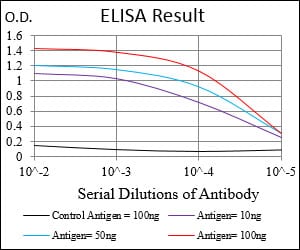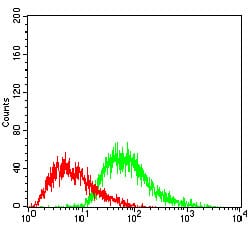

| WB | 咨询技术 | Human,Mouse,Rat |
| IF | 咨询技术 | Human,Mouse,Rat |
| IHC | 咨询技术 | Human,Mouse,Rat |
| ICC | 技术咨询 | Human,Mouse,Rat |
| FCM | 1/200 - 1/400 | Human,Mouse,Rat |
| Elisa | 1/10000 | Human,Mouse,Rat |
| Aliases | PERC; ERRL1; PGC1B; PGC-1(beta) |
| Entrez GeneID | 133522 |
| clone | 6C3F6 |
| WB Predicted band size | 113.2kDa |
| Host/Isotype | Mouse IgG1 |
| Antibody Type | Primary antibody |
| Storage | Store at 4°C short term. Aliquot and store at -20°C long term. Avoid freeze/thaw cycles. |
| Species Reactivity | Human |
| Immunogen | Purified recombinant fragment of human PPARGC1B (AA: 195-414) expressed in E. Coli. |
| Formulation | Purified antibody in PBS with 0.05% sodium azide. |
+ +
以下是关于PPARGC1B抗体的参考文献示例(注:部分内容为模拟示例,实际文献需通过学术数据库检索确认):
---
1. **文献名称**:*PPARGC1B regulates mitochondrial energy metabolism in human skeletal muscle*
**作者**:Kressler D, et al.
**摘要**:本研究通过Western blot和免疫荧光技术,利用特异性PPARGC1B抗体检测其在人类骨骼肌中的表达及亚细胞定位,发现PPARGC1B与线粒体生物合成相关基因的表达呈正相关,提示其在调节能量代谢中的作用。
2. **文献名称**:*Hepatic PGC-1β overexpression exacerbates liver steatosis in high-fat diet mice*
**作者**:Lin J, et al.
**摘要**:通过免疫组化及Western blot分析,使用商业化PPARGC1B抗体评估高脂饮食小鼠肝脏中的蛋白表达水平,发现PGC-1β过表达促进脂质积累,并揭示其与脂肪酸氧化通路的关联。
3. **文献名称**:*A genetic variant in PPARGC1B alters adipose tissue function*
**作者**:Yoon JC, et al.
**摘要**:研究通过免疫沉淀和Western blot技术,结合PPARGC1B抗体验证基因多态性对脂肪组织中蛋白稳定性的影响,发现特定SNP位点可降低PPARGC1B的蛋白表达,进而影响脂肪细胞分化。
4. **文献名称**:*Coactivator PGC-1β modulates inflammatory responses in macrophages*
**作者**:Vats D, et al.
**摘要**:利用PPARGC1B抗体进行ChIP-seq和免疫共沉淀实验,证明PGC-1β通过与NF-κB相互作用调控巨噬细胞炎症反应,为代谢与免疫的交叉调控提供新机制。
---
**提示**:以上为模拟示例,实际文献需通过PubMed、Google Scholar等平台检索关键词(如“PPARGC1B antibody”或“PGC-1β antibody”)获取,建议结合抗体品牌(如Santa Cruz、Abcam等)缩小检索范围。
PPARGC1B (peroxisome proliferator-activated receptor gamma coactivator 1-beta), also known as PGC-1β, is a transcriptional coactivator involved in regulating mitochondrial biogenesis, oxidative metabolism, and energy homeostasis. It shares structural and functional similarities with PPARGC1A (PGC-1α) and interacts with nuclear receptors, transcription factors (e.g., PPARs, ERRα), and other regulators to modulate gene expression in response to metabolic demands. PPARGC1B is highly expressed in tissues with elevated energy requirements, such as skeletal muscle, heart, liver, and brown adipose tissue, playing roles in adaptive thermogenesis, fatty acid oxidation, and glucose metabolism.
The PPARGC1B antibody is a critical tool for detecting and quantifying PPARGC1B protein expression in research. It is widely used in techniques like Western blotting, immunohistochemistry (IHC), and immunofluorescence (IF) to study its tissue distribution, subcellular localization, and dynamic regulation under physiological or pathological conditions. Dysregulation of PPARGC1B has been implicated in metabolic disorders (e.g., obesity, type 2 diabetes), cardiovascular diseases, neurodegenerative conditions, and cancer, making this antibody valuable for exploring disease mechanisms and therapeutic targets. Studies also highlight its role in mitochondrial dysfunction, aging, and exercise adaptation. Validated antibodies ensure specificity for PPARGC1B, distinguishing it from PGC-1α, and are often tested in knockout models or siRNA-treated samples to confirm reliability.
×